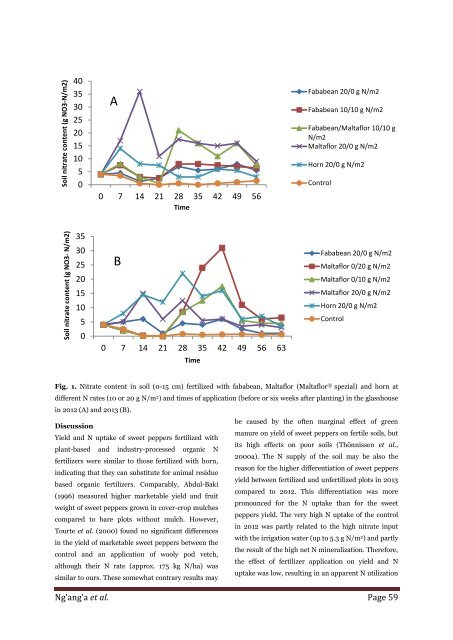Effect of organic fertilizers on apparent nitrogen utilization and yield of sweet pepper (Capsicum annuum L.) as influenced by fertilizer timing
A glasshouse experiment was carried out at the University of Natural resources and Life Sciences, Vienna, Austria during the months of April to September in both 2012 and 2013 to investigate the effect of organic fertilizers on apparent nitrogen utilization and yield of sweet pepper as influenced by fertilizer timing. In two subsequent years, sweet peppers were grown in glasshouse and fertilized with 20 g N/m2 as Maltaflor®-spezial, coarse meal of fababean and horn at different times within a 30 cm wide fertilizer-band. The experiment was laid out in a Complete Randomized Design (CRD) with four replications. Data was recorded on the various parameters and subjected to statistical analysis. Yields of tomatoes, plant N uptake and apparent N utilization obtained with Maltaflor®-spezial or fababean were comparable to those of horn in both years. The apparent N utilization did not exceed 19-33 % in the first year (2012) due to a high N uptake in the control, but increased in the following year (2013) to 26-57 %, because of the poorer growth in the unfertilized control. There were marked differences in the amount of NO3 --N remaining in soil during and after cultivation, so that the N supply by Maltaflor®-spezial was higher compared to fababean and horn. Split application of a readily available organic fertilizer could be promising and an additional N mineralization could be expected by a regular hoeing of formerly fertilized plots.
A glasshouse experiment was carried out at the University of Natural resources and Life Sciences, Vienna, Austria during the months of April to September in both 2012 and 2013 to investigate the effect of organic fertilizers on apparent nitrogen utilization and yield of sweet pepper as influenced by fertilizer timing. In two subsequent years, sweet peppers were grown in glasshouse and fertilized with 20 g N/m2 as Maltaflor®-spezial, coarse meal of fababean and horn at different times within a 30 cm wide fertilizer-band. The experiment was laid out in a Complete Randomized Design (CRD) with four replications. Data was recorded on the various parameters and subjected to statistical analysis. Yields of tomatoes, plant N uptake and apparent N utilization obtained with Maltaflor®-spezial or fababean were comparable to those of horn in both years. The apparent N utilization did not exceed 19-33 % in the first year (2012) due to a high N uptake in the control, but increased in the following year (2013) to 26-57 %, because of the poorer growth in the unfertilized control. There were marked differences in the amount of NO3 --N remaining in soil during and after cultivation, so that the N supply by Maltaflor®-spezial was higher compared to fababean and horn. Split application of a readily available organic fertilizer could be promising and an additional N mineralization could be expected by a regular hoeing of formerly fertilized plots.
You also want an ePaper? Increase the reach of your titles
YUMPU automatically turns print PDFs into web optimized ePapers that Google loves.
Soil nitrate c<strong>on</strong>tent (g NO3- N/m2)<br />
Soil nitrate c<strong>on</strong>tent (g NO3-N/m2)<br />
40<br />
35<br />
30<br />
25<br />
20<br />
15<br />
10<br />
5<br />
0<br />
A<br />
0 7 14 21 28 35 42 49 56<br />
Time<br />
Fababean 20/0 g N/m2<br />
Fababean 10/10 g N/m2<br />
Fababean/Maltaflor 10/10 g<br />
N/m2<br />
Maltaflor 20/0 g N/m2<br />
Horn 20/0 g N/m2<br />
C<strong>on</strong>trol<br />
35<br />
30<br />
25<br />
20<br />
15<br />
10<br />
5<br />
0<br />
B<br />
0 7 14 21 28 35 42 49 56 63<br />
Time<br />
Fababean 20/0 g N/m2<br />
Maltaflor 0/20 g N/m2<br />
Maltaflor 0/10 g N/m2<br />
Maltaflor 20/0 g N/m2<br />
Horn 20/0 g N/m2<br />
C<strong>on</strong>trol<br />
Fig. 1. Nitrate c<strong>on</strong>tent in soil (0-15 cm) fertilized with fababean, Maltaflor (Maltaflor ® spezial) <strong>and</strong> horn at<br />
different N rates (10 or 20 g N/m 2 ) <strong>and</strong> times <str<strong>on</strong>g>of</str<strong>on</strong>g> applicati<strong>on</strong> (before or six weeks after planting) in the gl<strong>as</strong>shouse<br />
in 2012 (A) <strong>and</strong> 2013 (B).<br />
Discussi<strong>on</strong><br />
Yield <strong>and</strong> N uptake <str<strong>on</strong>g>of</str<strong>on</strong>g> <strong>sweet</strong> <strong>pepper</strong>s fertilized with<br />
be caused <strong>by</strong> the <str<strong>on</strong>g>of</str<strong>on</strong>g>ten marginal effect <str<strong>on</strong>g>of</str<strong>on</strong>g> green<br />
manure <strong>on</strong> <strong>yield</strong> <str<strong>on</strong>g>of</str<strong>on</strong>g> <strong>sweet</strong> <strong>pepper</strong>s <strong>on</strong> fertile soils, but<br />
plant-b<strong>as</strong>ed <strong>and</strong> industry-processed <str<strong>on</strong>g>organic</str<strong>on</strong>g> N<br />
its high effects <strong>on</strong> poor soils (Thönnissen et al.,<br />
<str<strong>on</strong>g><strong>fertilizer</strong>s</str<strong>on</strong>g> were similar to those fertilized with horn,<br />
indicating that they can substitute for animal residue<br />
b<strong>as</strong>ed <str<strong>on</strong>g>organic</str<strong>on</strong>g> <str<strong>on</strong>g><strong>fertilizer</strong>s</str<strong>on</strong>g>. Comparably, Abdul-Baki<br />
(1996) me<strong>as</strong>ured higher marketable <strong>yield</strong> <strong>and</strong> fruit<br />
weight <str<strong>on</strong>g>of</str<strong>on</strong>g> <strong>sweet</strong> <strong>pepper</strong>s grown in cover-crop mulches<br />
compared to bare plots without mulch. However,<br />
Tourte et al. (2000) found no significant differences<br />
in the <strong>yield</strong> <str<strong>on</strong>g>of</str<strong>on</strong>g> marketable <strong>sweet</strong> <strong>pepper</strong>s between the<br />
c<strong>on</strong>trol <strong>and</strong> an applicati<strong>on</strong> <str<strong>on</strong>g>of</str<strong>on</strong>g> wooly pod vetch,<br />
although their N rate (approx. 175 kg N/ha) w<strong>as</strong><br />
similar to ours. These somewhat c<strong>on</strong>trary results may<br />
2000a). The N supply <str<strong>on</strong>g>of</str<strong>on</strong>g> the soil may be also the<br />
re<strong>as</strong><strong>on</strong> for the higher differentiati<strong>on</strong> <str<strong>on</strong>g>of</str<strong>on</strong>g> <strong>sweet</strong> <strong>pepper</strong>s<br />
<strong>yield</strong> between fertilized <strong>and</strong> unfertilized plots in 2013<br />
compared to 2012. This differentiati<strong>on</strong> w<strong>as</strong> more<br />
pr<strong>on</strong>ounced for the N uptake than for the <strong>sweet</strong><br />
<strong>pepper</strong>s <strong>yield</strong>. The very high N uptake <str<strong>on</strong>g>of</str<strong>on</strong>g> the c<strong>on</strong>trol<br />
in 2012 w<strong>as</strong> partly related to the high nitrate input<br />
with the irrigati<strong>on</strong> water (up to 5.3 g N/m 2 ) <strong>and</strong> partly<br />
the result <str<strong>on</strong>g>of</str<strong>on</strong>g> the high net N mineralizati<strong>on</strong>. Therefore,<br />
the effect <str<strong>on</strong>g>of</str<strong>on</strong>g> <strong>fertilizer</strong> applicati<strong>on</strong> <strong>on</strong> <strong>yield</strong> <strong>and</strong> N<br />
uptake w<strong>as</strong> low, resulting in an <strong>apparent</strong> N utilizati<strong>on</strong><br />
Ng’ang’a et al. Page 59


















